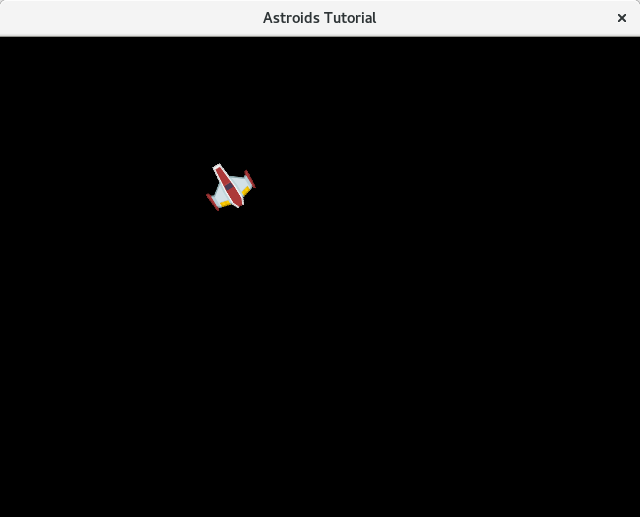Move Player Sprite
Simple Astroids clone
Published
Liked the article? Share it!

When the user presses the up arrow on the keyboard, we will move the player sprite in the direction it is facing. We use sin and cos to break the rotation into x and y components to allow us to move the sprite.
main.c
#include <epoxy/gl.h>
#include <epoxy/glx.h>
#include <gtk/gtk.h>
#include <math.h>
#include "DashGL/dashgl.h"
static void on_realize(GtkGLArea *area);
static void on_render(GtkGLArea *area, GdkGLContext *context);
static gboolean on_idle(gpointer data);
static gboolean on_keydown(GtkWidget *widget, GdkEventKey *event);
static gboolean on_keyup(GtkWidget *widget, GdkEventKey *event);
#define WIDTH 640.0f
#define HEIGHT 480.0f
GLuint program;
GLuint vao;
GLint attribute_texcoord, attribute_coord2d;
GLint uniform_mytexture, uniform_mvp;
struct {
GLuint vbo;
GLuint tex;
vec3 pos;
mat4 mvp;
gboolean left;
gboolean right;
gboolean up;
GLfloat rot;
} player;
int main(int argc, char *argv[]) {
GtkWidget *window;
GtkWidget *glArea;
gtk_init(&argc, &argv);
// Initialize Window
window = gtk_window_new(GTK_WINDOW_TOPLEVEL);
gtk_window_set_title(GTK_WINDOW(window), "Astroids Tutorial");
gtk_window_set_position(GTK_WINDOW(window), GTK_WIN_POS_CENTER);
gtk_window_set_default_size(GTK_WINDOW(window), 640, 480);
gtk_window_set_type_hint(GTK_WINDOW(window), GDK_WINDOW_TYPE_HINT_UTILITY);
g_signal_connect(window, "destroy", G_CALLBACK(gtk_main_quit), NULL);
g_signal_connect(window, "key-press-event", G_CALLBACK(on_keydown), NULL);
g_signal_connect(window, "key-release-event", G_CALLBACK(on_keyup), NULL);
// Initialize GTK GL Area
glArea = gtk_gl_area_new();
gtk_widget_set_vexpand(glArea, TRUE);
gtk_widget_set_hexpand(glArea, TRUE);
g_signal_connect(glArea, "realize", G_CALLBACK(on_realize), NULL);
g_signal_connect(glArea, "render", G_CALLBACK(on_render), NULL);
gtk_container_add(GTK_CONTAINER(window), glArea);
// Show widgets
gtk_widget_show_all(window);
gtk_main();
return 0;
}
static void on_realize(GtkGLArea *area) {
// Debug Message
g_print("on realize\n");
gtk_gl_area_make_current(area);
if(gtk_gl_area_get_error(area) != NULL) {
fprintf(stderr, "Unknown error\n");
return;
}
const GLubyte *renderer = glGetString(GL_RENDER);
const GLubyte *version = glGetString(GL_VERSION);
printf("Renderer: %s\n", renderer);
printf("OpenGL version supported %s\n", version);
glClearColor(0.0f, 0.0f, 0.0f, 1.0f);
glGenVertexArrays(1, &vao);
glBindVertexArray(vao);
GLfloat player_vertices[] = {
-24.0, -24.0, 0.0, 0.0,
-24.0, 24.0, 0.0, 1.0,
24.0, 24.0, 1.0, 1.0,
-24.0, -24.0, 0.0, 0.0,
24.0, 24.0, 1.0, 1.0,
24.0, -24.0, 1.0, 0.0
};
glGenBuffers(1, &player.vbo);
glBindBuffer(GL_ARRAY_BUFFER, player.vbo);
glBufferData(
GL_ARRAY_BUFFER,
sizeof(player_vertices),
player_vertices,
GL_STATIC_DRAW
);
player.pos[0] = WIDTH / 2.0f;
player.pos[1] = HEIGHT / 2.0f;
player.pos[2] = 0.0;
player.left = FALSE;
player.right = FALSE;
player.up = FALSE;
mat4_translate(player.pos, player.mvp);
player.tex = shader_load_texture("sprites/player.png");
const char *vs = "shader/vertex.glsl";
const char *fs = "shader/fragment.glsl";
program = shader_load_program(vs, fs);
const char *attribute_name = "coord2d";
attribute_coord2d = glGetAttribLocation(program, attribute_name);
if(attribute_coord2d == -1) {
fprintf(stderr, "Could not bind attribute %s\n", attribute_name);
return;
}
const char *uniform_name = "orthograph";
GLint uniform_ortho = glGetUniformLocation(program, uniform_name);
if(uniform_ortho == -1) {
fprintf(stderr, "Could not bind uniform %s\n", uniform_name);
return;
}
uniform_name = "mvp";
uniform_mvp = glGetUniformLocation(program, uniform_name);
if(uniform_mvp == -1) {
fprintf(stderr, "Could not bind uniform %s\n", uniform_name);
return;
}
glUseProgram(program);
mat4 orthograph;
mat4_orthagonal(WIDTH, HEIGHT, orthograph);
glUniformMatrix4fv(uniform_ortho, 1, GL_FALSE, orthograph);
g_timeout_add(20, on_idle, (void*)area);
}
static void on_render(GtkGLArea *area, GdkGLContext *context) {
glClear(GL_COLOR_BUFFER_BIT | GL_DEPTH_BUFFER_BIT);
glUseProgram(program);
glBindVertexArray(vao);
glEnableVertexAttribArray(attribute_coord2d);
glEnableVertexAttribArray(attribute_texcoord);
glActiveTexture(GL_TEXTURE0);
glBindTexture(GL_TEXTURE_2D, player.tex);
glUniform1i(uniform_mytexture, 0);
mat4 pos, rot;
mat4_translate(player.pos, pos);
mat4_rotate_z(player.rot, rot);
mat4_multiply(pos, rot, player.mvp);
glUniformMatrix4fv(uniform_mvp, 1, GL_FALSE, player.mvp);
glBindBuffer(GL_ARRAY_BUFFER, player.vbo);
glVertexAttribPointer(
attribute_coord2d,
2,
GL_FLOAT,
GL_FALSE,
sizeof(float) * 4,
0
);
glVertexAttribPointer(
attribute_texcoord,
2,
GL_FLOAT,
GL_FALSE,
sizeof(float) * 4,
(void*)(sizeof(float) * 2)
);
glDrawArrays(GL_TRIANGLES, 0, 6);
glDisableVertexAttribArray(attribute_coord2d);
glDisableVertexAttribArray(attribute_texcoord);
}
static gboolean on_idle(gpointer data) {
if(player.right) {
player.rot -= 0.05f;
}
if(player.left) {
player.rot += 0.05f;
}
float dx, dy;
if(player.up) {
player.pos[0] -= sin(player.rot);
player.pos[1] += cos(player.rot);
}
gtk_widget_queue_draw(GTK_WIDGET(data));
return TRUE;
}
static gboolean on_keydown(GtkWidget *widget, GdkEventKey *event) {
switch(event->keyval) {
case GDK_KEY_Left:
player.left = TRUE;
break;
case GDK_KEY_Right:
player.right = TRUE;
break;
case GDK_KEY_Up:
player.up = TRUE;
break;
}
}
static gboolean on_keyup(GtkWidget *widget, GdkEventKey *event) {
switch(event->keyval) {
case GDK_KEY_Left:
player.left = FALSE;
break;
case GDK_KEY_Right:
player.right = FALSE;
break;
case GDK_KEY_Up:
player.up = FALSE;
break;
}
}
Compile
$ gcc -c -o DashGL/dashgl.o DashGL/dashgl.c -lepoxy -lpng -lm
$ gcc `pkg-config --cflags gtk+-3.0` main.c DashGL/dashgl.o `pkg-config --libs gtk+-3.0` \
-lepoxy -lm -lpngRun
$ ./a.out